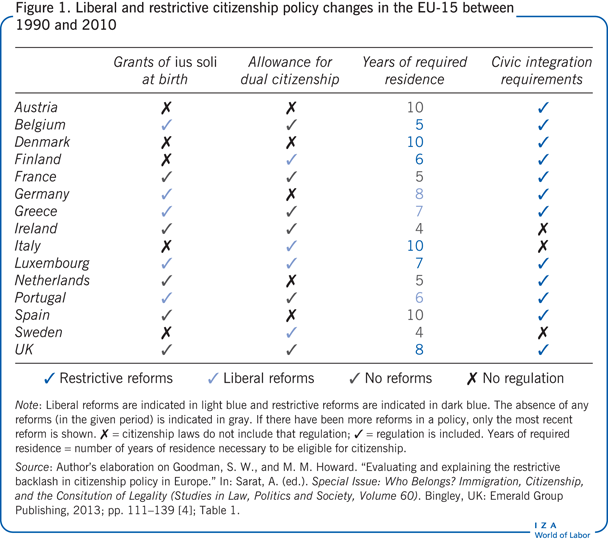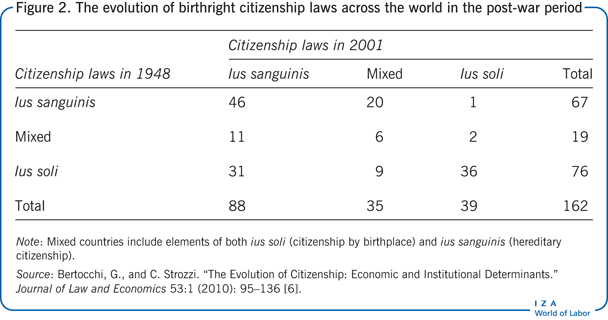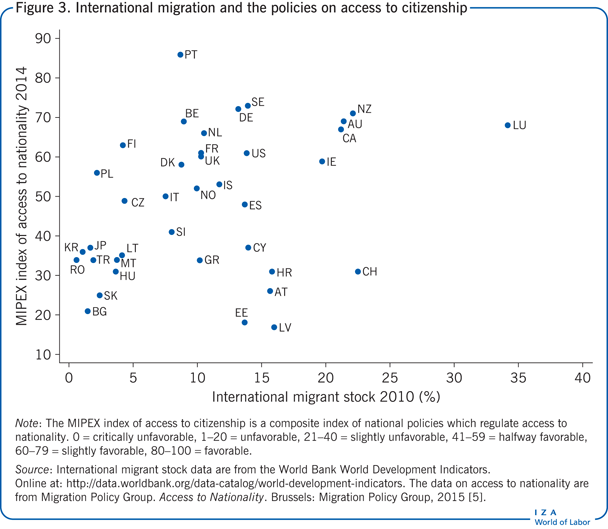Elevator pitch
Citizenship laws are changing in many countries. Although cross-national differences in the laws regulating access to citizenship are today not as large as they were several decades ago, they are still very apparent. Globally, there is convergence over some citizenship policy dimensions, but there is not a general convergence over “liberal” or “restrictive” approaches to citizenship policy. A growing body of research has put forward various comparative measures of citizenship and migrant integration policies. However, selecting the “right” index is a challenging task, and the underlying dynamics of citizenship laws are not easy to interpret as they differ across countries.
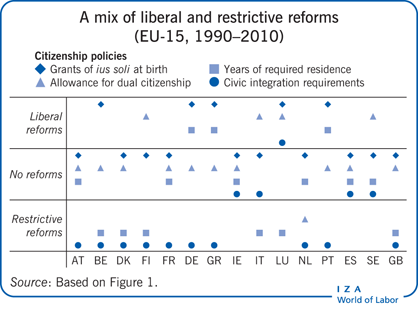
Key findings
Pros
Citizenship policies are a crucial determinant of the degree of migrant integration.
The evolution of citizenship laws is key to understanding the dynamics of international migration.
Citizenship policy is at center stage of the political agenda in many countries, which suggests its high relevance to national policy.
Many new measures of citizenship and migrant integration policies have recently been introduced.
Cons
The direction of recent changes in citizenship policies is not definite: there is not a general convergence on liberalism or restrictiveness.
The available measures of citizenship and migrant integration policies cannot be easily interpreted and compared.
Citizenship is only one element of migrant integration.
The relationship between the degree of liberalism in citizenship policies and the size of the international migrant population is positive but not robust.
Author's main message
Citizenship is key to improving the socio-economic and political integration of immigrants. Laws regulating access to citizenship are however only one element of migrant integration. Politicians should consider citizenship in combination with labor market and educational policies in order to design appropriate integration policies. In today’s multicultural societies, the traditional notion of citizenship as belonging to a particular nation state needs to be reviewed. A new concept of citizenship should be considered that recognizes people as mobile individuals who are interconnected and interdependent across national boundaries. Citizenship and the associated rights and duties should be based predominantly on the principle of residence in a territory, thus encouraging migrant self-determination and integration. Citizenship education would be a key policy tool for embedding this new, inclusive vision.
Motivation
The past decades have witnessed a significant transformation in citizenship policies, in many countries of the world. While there is a degree of convergence in some dimensions of citizenship policies across countries (such as those related to dual citizenship liberalization, which account for about three-quarters of all citizenship liberalization policies in Europe since the 1980s), it is nevertheless not easy to conclude whether there is a general convergence toward more liberal or more restrictive policies. Liberal citizenship policies are generally inclusive of certain groups, or allow for a greater number of immigrants to become citizens through relatively easier citizenship requirements, restrictive citizenship policies are, instead, exclusive of certain types of groups, or allow for a smaller proportion of immigrants to become citizens through relatively more difficult citizenship requirements. Effectively, citizenship regimes cannot be reduced to a unique dimension of inclusiveness: they may be inclusive toward some groups while exclusive toward others.
The current increasing pressure of international migration has brought citizenship policies to center stage on policy agendas. Citizenship laws indeed affect not only immigration policy, but also labor markets, welfare programs, and demographic trends. Research has shown that naturalized immigrants are actually better able to integrate in the host-country labor market (due to access to better jobs, different occupations, etc.), contribute more to the social welfare system (due to the higher wages they earn), and help to reverse demographic trends in society (due to their younger age with respect to the host-country population).
Discussion of pros and cons
What is citizenship?
Citizenship is the legal institution that designates full membership of an individual in a state, with the associated rights and duties that entails. A state grants certain political, social, and legal rights to its citizens and, in return, citizens are expected to assume certain responsibilities toward the state. Citizenship provides benefits, such as the right to vote, better employment opportunities, the ability to travel without restrictions, legal protection in case of criminal charges, and the possibility to obtain a visa for a relative. There are also costs to citizenship, such as the military draft, renunciation of the original citizenship, and the pecuniary and non-pecuniary costs that may be required for naturalization and for recognition at the age of majority.
Citizenship also indicates “belonging” to a country, thereby drawing boundaries between foreigners and nationals. In the presence of societies characterized by people originating from different countries and cultures, however, the dividing line between belonging and separation appears to be more difficult to adequately identify. The traditional concept of citizenship, based on the idea of a coherence between a culture and a nation, indeed does not imply cultural diversity, and therefore appears inadequate to accommodate for the cultural differences that characterize current multicultural societies.
Recent changes in citizenship laws
Citizenship policies, both in Europe and in North America, have undergone a process of significant transformation over recent decades. While traditionally restrictive states have introduced important reforms to liberalize access to citizenship, other liberal countries have taken steps toward introducing more restrictive regulations. The extent of liberal and restrictive reforms has differed considerably across countries.
Steps toward liberalization in Europe have followed the liberal reforms of the 1980s and the 1990s, consisting mainly of facilitating access to citizenship to second-generation immigrants (e.g. in Germany and Italy) and of allowing for the possibility of holding dual citizenship (e.g. in Finland, Luxembourg, and Sweden). There have also been reforms to reduce the number of years of residence that are required in order to be eligible for citizenship (e.g. in Luxembourg and Portugal) [1]. Since all these liberal steps have been concentrated in a relatively short period of time, some scholars have interpreted this as evidence of a process of liberal convergence among European countries [2]. This conclusion, however, does not match the available evidence on the evolution of citizenship laws. Indeed, within the same period a number of traditionally liberal countries have implemented restrictive regulations, in turn initiating a debate over the surge of a restrictive backlash [3], [4].
The moves toward more restrictive regulations have mainly taken the form of an increase in residency durations (e.g. in Belgium and Luxembourg), the prohibition of holding dual citizenship (in the Netherlands), and the adoption of compulsory requirements as part of the process to obtain permanent residence or naturalization, mostly consisting of assessing language and country knowledge (e.g. in Austria, Denmark, France, Germany, the Netherlands, and the UK). Citizenship policies have also recently been restricted in Greece, where in 2013 the Council of State annulled the major liberal reform of 2010, and in Canada [5].
In summary, what emerges from the last decades is that there has been a combination of both liberalizing and restrictive citizenship policies in Europe, though neither the liberal nor the restrictive hypothesis can be considered appropriate (Figure 1) [4].
Evidence from around the world on the evolution of citizenship law offers a similar picture: that is, there is no general convergence between liberal and restrictive policies. More particularly, in terms of the laws that regulate access to citizenship at birth, most countries are now characterized by a mixed regime in which both liberal (ius soli) and restrictive (ius sanguinis) elements are in place [6]. The ius soli principle establishes that citizenship is attributed by birthplace: this implies that the child of an immigrant is a citizen as long as s/he is born in the country of immigration. The ius sanguinis principle establishes that citizenship is attributed by descent, so that a child inherits citizenship from his/her parents, independent of where s/he is born.
Despite the fact that ius soli is rooted in the legal tradition of common law and ius sanguinis is rooted in the legal tradition of civil law, in many countries during the 20th century (and particularly in the post-war period), the regulation of citizenship laws at birth has gone through a process of continuous transformation. The three major patterns of birthright citizenship law dynamics around the world have been the following (see Figure 2): (i) “stability” (e.g. the US, Canada, and New Zealand, which have remained steadily ius soli since World War II); (ii) “switch” (e.g. former UK colonies that switched from ius soli to ius sanguinis at the time of independence); (iii) “convergence” over a mixed regime (e.g. Australia and the UK, which started from ius soli; and Continental Europe, where most countries started from ius sanguinis).
According to the latest figures from the Migrant Integration Policy Index (MIPEX) (a well-known index of migrant integration that includes information on birthright citizenship), in 2014, out of a total 38 countries around the world eight were favorable toward birthright citizenship for second-generation immigrants (MIPEX index: 100), while 20 countries were critically unfavorable (MIPEX index: 0). The remaining 10 countries were halfway favorable (MIPEX index: 50). Moreover, regarding the policies that regulate access to nationality (including not only birthright citizenship but also regulations such as those on dual citizenship and on the years of required residence to be eligible for citizenship), 13 countries out of 38 were favorable, or slightly favorable (MIPEX index: 60–100), and 16 countries out of 38 were unfavorable or slightly unfavorable (MIPEX index: 1–40). The rest were halfway favorable (MIPEX index: 41–59) [5].
International migration is certainly a potential relevant determinant of the evolution of citizenship legislation. According to the latest available MIPEX data it appears that, across countries, there is a positive relationship between the stock of international migrants and the degree of liberalism in the policies that regulate access to nationality. The significance of this relationship, however, cannot be considered robust, in part due to the presence of outlier countries such as Luxembourg (Figure 3). This suggests that the countries with a larger stock of international migrants are not necessarily those with more liberal citizenship policies.
Determinants of the evolution of citizenship laws
Contemporary socio-political and economic scholars have indicated several potential determinants of the evolution of citizenship laws. Notwithstanding the differences in their contributions, a number of common explanations emerge. The legal tradition of a country appears to affect the legislation that regulates the acquisition of citizenship at birth: most countries with a common law tradition have indeed adopted the ius soli principle, while most countries with a tradition of civil law have adopted the ius sanguinis principle. Border instability and historical events, such as de-colonization, have a negative impact on inclusiveness: indeed, former ius soli colonies have abandoned this in favor of ius sanguinis after having achieved independence [6]. A higher level of democracy is instead associated with more inclusiveness: the countries that were democratic in the 19th century have developed a more inclusive concept of national identity and have been more inclined to allow foreigners to become members of society.
Furthermore, being a former colonial power is an important determinant of the evolution of citizenship laws: these states generally have been more inclusive toward the people belonging to their colonies [1]. Citizenship laws have been also strictly related to migration flows. Large-scale migration, in general, has produced a negative impact on inclusiveness, but in ius sanguinis countries it has led to a shift of the legislation toward a mixed regime, with both ius soli and ius sanguinis elements [6].
Finally, some political factors play a role in the development of citizenship laws. The presence of strong populist parties and the introduction of particular petition campaigns appear to be negatively related to citizenship liberalization (e.g. in Austria, Denmark, Italy, and Germany). At the same time, liberalization has occurred in some countries where far-right political parties are weak or absent (e.g. in Spain and Portugal) [1].
In sum, the evidence shows that citizenship laws have responded endogenously and systematically to historical, economic, and institutional factors and that they have been jointly determined with other institutions.
New measures of citizenship and migrant integration policies
There has been a boom in the development of citizenship and migrant integration policy indicators, which has given rise to a growing body of comparative research on the topic [7]. All the available indices and indicators classify citizenship regimes on a scale that goes from the most liberal (inclusionary) to the most restrictive (exclusionary). Apart from policies regulating access to citizenship, migrant integration policies generally include policies related to anti-discrimination, access to labor markets, labor migration, family reunification, political participation, and educational, cultural, and religious rights.
Currently, the major indexes of citizenship policies are the following: MIPEX [8]; the Citizenship Policy Index (CPI) [1]; the Barriers to Naturalization Index (BNI) [9]; Koning’s index on naturalization policies [10]; the Indicators for Citizenship Rights of Immigrants (ICRI) [11]; and the EUDO “Citizenship Law Indicators” (CITLAW) [7].
In the presence of global changes in citizenship and migrant integration policies, the use of these new comparative indices can be extremely useful for undertaking cross-country analyses that can fully investigate the determinants of these policies and their effects on the socio-economic and political integration of migrants.
Citizenship policy is certainly a central step in the process of formal incorporation of immigrants. However, although it is necessary for full integration it is only one element of social and economic integration of immigrants. Taking this into account, a significant amount of research has been conducted on developing more general indices of migrant integration, which collect and analyze information on policies, such as the procedures for immigration admission, naturalization, and other migrant integration policies.
Citizenship in multicultural societies
As previously discussed, the traditional concept of citizenship does not explicitly embrace cultural diversity, and so fails to accommodate the cultural differences that characterize today’s multicultural societies. Defining multiculturalism, however, is not simple. For example, it can be defined exclusively in demographic terms, in philosophical terms, or it can be recognized as a political orientation by government or institutions toward ethnically and culturally diverse societies. It has been argued that multiculturalism undermines social capital, social cohesion, and national cultural values. This view has contributed to the recent surge of far-right political parties in many European countries, including the Netherlands, Sweden, Finland, Denmark, Norway, and France. At the same time, there have been concerns over multiculturalism within the political mainstream. In 2010, the German Chancellor, Angela Merkel, admitted that multiculturalism was a failure in Germany, and in 2015 she confirmed her previous belief, saying that it remains “a life lie” and is a “sham” [12]. The former British Prime Minister, David Cameron, was of the same opinion in 2011, arguing that multiculturalism failed to promote a sense of common identity within society. According to these political views, multiculturalism is potentially a problem, mainly because it can lead to the emergence of isolated societies within host countries.
Although there is a perception that the multicultural approach has failed, the evidence tells that in contemporary Europe most countries adopted multicultural policies in the latter part of the 20th century and have maintained this approach into the first decade of the new century, though with some exceptions (e.g. the Netherlands). According to the Multiculturalism Policy Index, in 2010 most Western liberal democracies were characterized either by an intermediate or a strong level of multiculturalism: the countries with a higher degree of multiculturalism were Australia, Canada, Finland, and Sweden (Figure 4) [13].
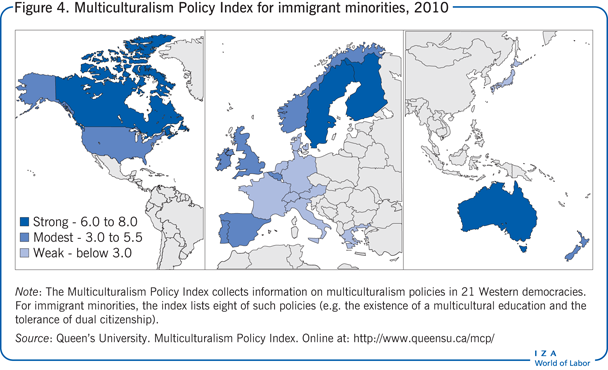
Limitations and gaps
Citizenship laws in many countries have undergone a process of significant transformation over the last decades. However, there does not appear to be a common direction of these changes. Indeed, not only have there been both liberal and restrictive reforms (also within the same country), but it is also not straightforward to classify the type of citizenship policies that have been configured. Indeed, citizenship regimes simply cannot be reduced to a unique dimension of inclusiveness: they may be inclusive toward some people while exclusive toward others. For example, they can be inclusive toward emigrants, and exclusive toward immigrants, or vice versa. Alternatively, they can be inclusive toward both groups or toward neither of them [7].
Although there have recently been many reforms of policies that regulate access to citizenship, overall they remain a major area of weakness for most European countries. In many countries the path to citizenship is difficult, long and costly: the result is that foreign people are discouraged from becoming new citizens, and the naturalization rate is consequently relatively low [5].
To date, there are many different measures of citizenship and migrant integration policies, and the presence of such a number of indices is certainly an important contribution to the growing body of research on the dynamics and determinants of the evolution of citizenship laws. However, selecting the “right” index is far from straightforward, for a number of reasons. First, there are many different indices that attempt to measure the same phenomenon. Second, some indices describe only citizenship policies, while others consider citizenship policies in the broad context of migrant integration policies. Among the major indices mentioned above, while CPI, BNI, and CITLAW only include a classification of citizenship policies, ICRI and MIPEX also include information on other migrant integration policies. Third, there is no consensus on the definition of an appropriate citizenship policy indicator. Last but not least, all these indices include very little or no information about migration policies related to refugees, asylum seekers, and illegal immigrants, who are often the mainspring of political action directed at restricting immigration. All these issues can lead to misinterpretations and complicate the possibility of correctly identifying and interpreting the dynamics of citizenship laws and migration policies.
Summary and policy advice
Citizenship laws have undergone a process of continuous transformation in many countries of the world over the last decades. They have evolved in many different ways, and the differences across countries remain significant. Recent changes in citizenship laws show a combination of both liberalizing and restrictive measures, yet there has been a lack of convergence across countries. To better understand the current and past dynamics of citizenship and migration policies, a growing body of research has elaborated various comparative measures of citizenship and migrant integration policies. However, selecting the “right” index is a difficult task and it is not always easy to interpret and identify the underlying dynamics of citizenship laws.
The laws that regulate access to citizenship are a key element of migrant integration, but it is not the only one: politicians should take into account citizenship policy alongside the role of labor market and educational policies in migrant integration. An explicit or implicit multicultural policy also plays a role in this process. This is particularly the case when taking into account the fact that immigrants living in countries where multicultural policies are in place are also more likely to become citizens. Reforms in citizenship policies should therefore be coupled not only with other migrant integration policies, but also with a multicultural approach that facilitates migrant integration and increases the benefits of diversity.
In today’s globalized world a more comprehensive understanding of the relationships between citizenship and migration is needed. The study of citizenship and migration should be investigated from a range of different perspectives. Social scientists as well as politicians should consider the implications of large-scale migration for the traditional notion of nation-state citizenship. A new concept of citizenship should be considered—one in which citizenship is not based on cultural belonging or on nationality and does not have an ethno-nationalistic conception. In a multicultural world in which people are mobile across countries, citizenship and the associated rights and duties should be based mainly on the principle of residence in a territory (ius domicilii), where the reference territory is the destination country. This principle does not necessarily exclude the possibility to hold some civil and political rights in another country (e.g. the country of origin), but shifts the focus onto the actual possibility for a migrant to be fully included in the social and political life of the country where s/he lives. This view has consequences that can be perceived under both a subjective and an objective dimension; on the one hand it can reinforce the link between citizenship and individual self-determination, and on the other hand it can strengthen social inclusion.
In many countries the naturalization process is linked to the number of years of residence, but often this requires an interval of uninterrupted residence in the destination country that is too long to be considered a real incentive for a migrant to become part of the host society. Moreover, while in some countries measures have been adopted to reduce the period of residence necessary to qualify for citizenship, at the same time there have been restrictive reforms related to civic integration requirements for applying for citizenship (such as tests assessing the language and knowledge of the host country). Arguably, a period of around five years’ uninterrupted residence should be sufficient for a migrant to apply for citizenship, provided that there is not the obligation of passing some civic integration tests and/or of demonstrating a certain minimum level of income (in line, for example, with the current citizenship law reform proposal in Italy). Otherwise, citizenship would be strictly related to a certain level of civic and national “identity” and/or to census.
For children of migrants, or young people who arrived in the host county before the age of majority, a requirement for applying for citizenship could be the completion of a certain minimum number of years in the education system in the host country (ius culturae), which is also in line with citizenship reform proposals in some countries (e.g. Italy). What is most important, though, is that provided the necessary conditions are verified, citizenship should be a right for everyone, in line with other political, social, and human rights, and not a concession by the state in response to a request by the migrant.
Citizenship education would be a key tool for enlightening society and for providing citizens and non-citizens with the capacities, skills, and intercultural competencies that are appropriate and necessary for engendering a more inclusive approach to citizenship. Minimum requirements in this respect would be: an ability to see things from another’s perspective; an ability to listen, to adapt, and to build relationships from a point of cultural humility; respect for difference. Policymakers should consider encouraging, developing, and implementing educational programs across political, social, and cultural institutions in order to engender a society that would pave the way for a more enlightened approach to citizenship and appropriate legislation.
Acknowledgments
The author thanks an anonymous referee and the IZA World of Labor editors for many helpful suggestions on earlier drafts. Previous work of the author contains a larger number of background references for the material presented here and has been used in some parts of this article [6].
Competing interests
The IZA World of Labor project is committed to the IZA Guiding Principles of Research Integrity. The author declares to have observed these principles.
© Chiara Strozzi
